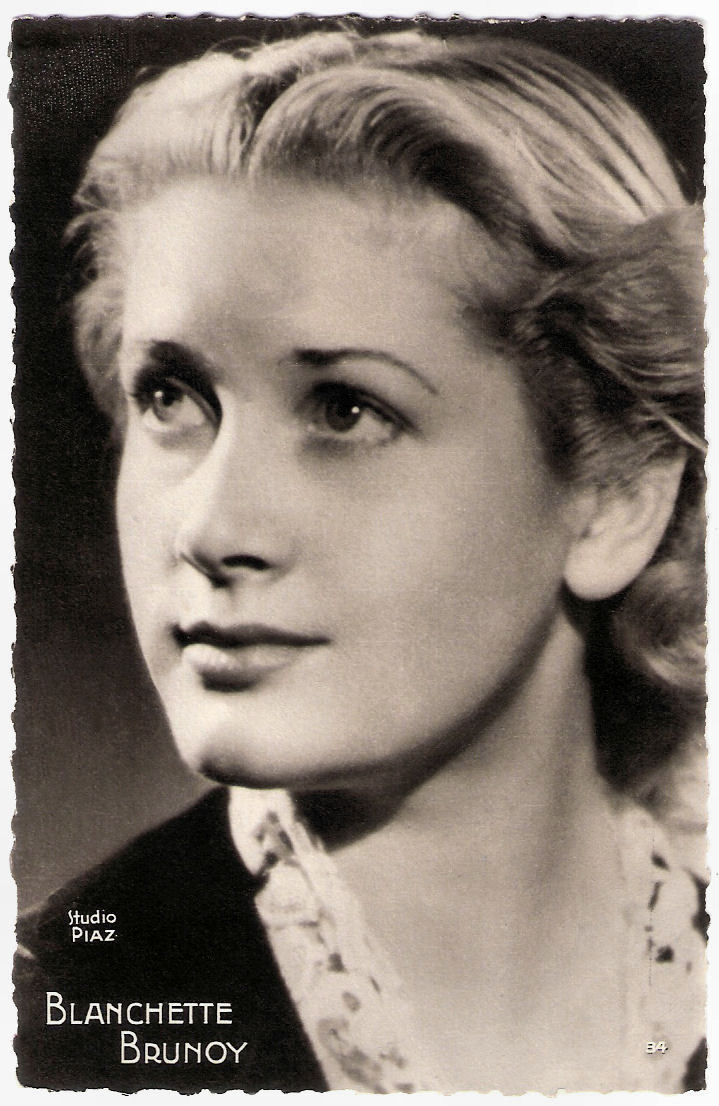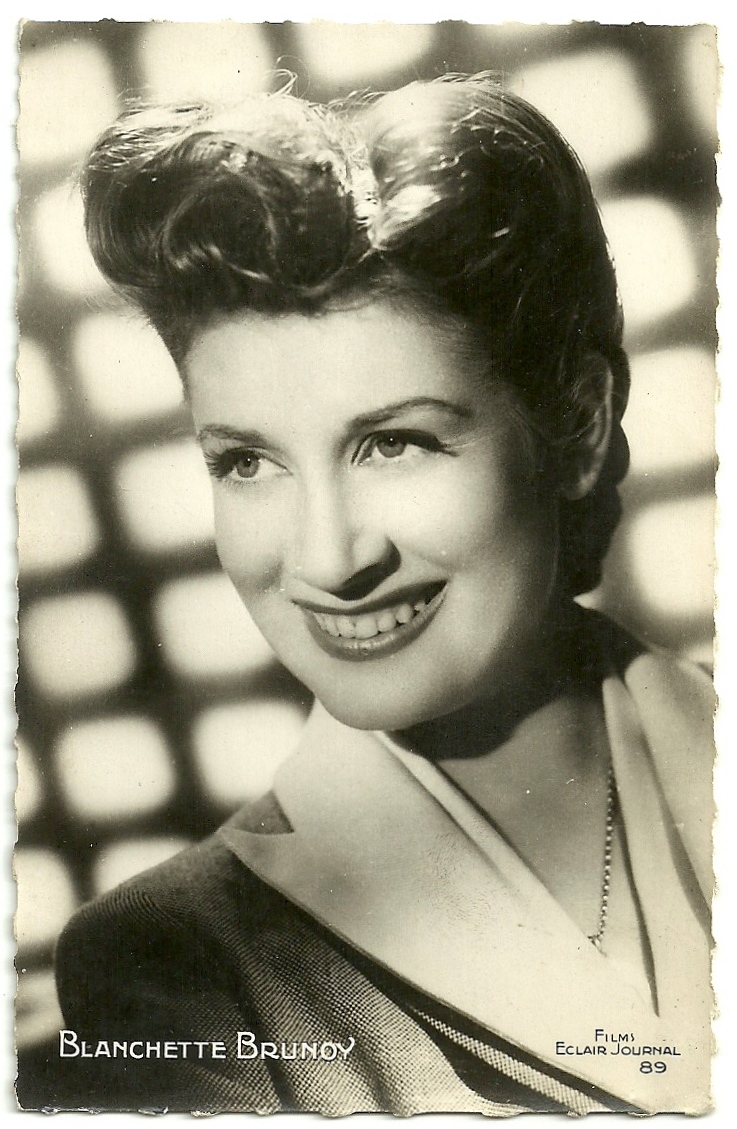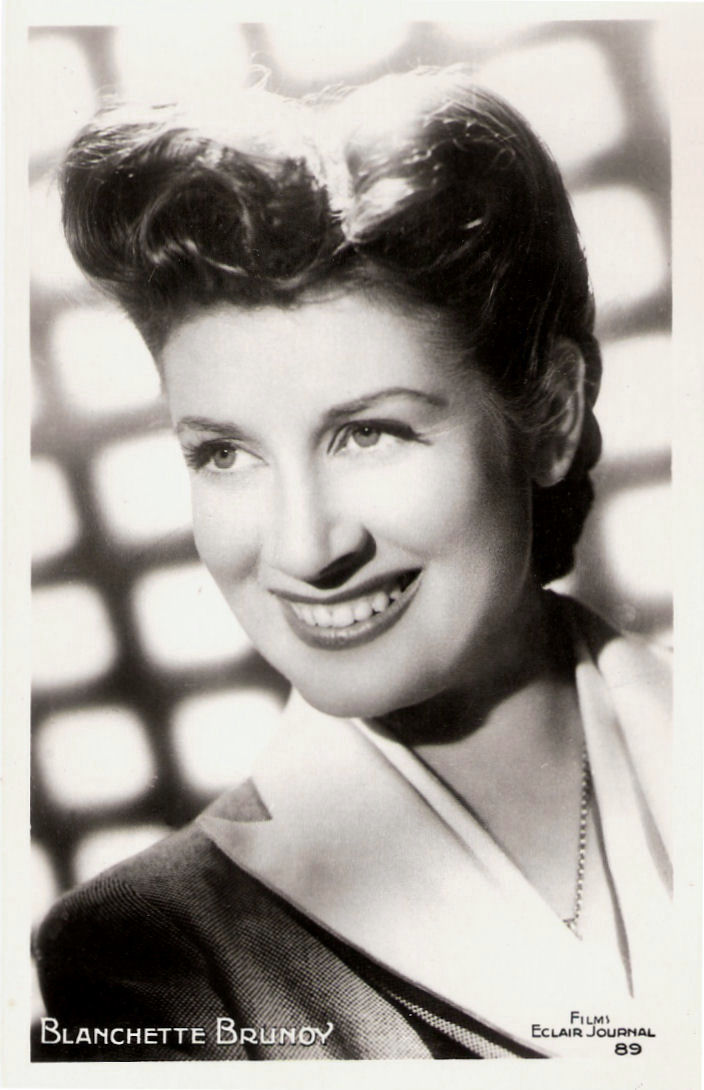
French postcard by Editions P.I., Paris, no. 12.
An abundance of authentic gallic atmosphere
Blanchette Brunoy was born Blanche Bilhaud in Paris in 1915. She was the daughter of a physician, Marcel Bilhaud, and the niece and goddaughter of writer Georges Duhamel. Thanks to him, she discovered the theatre.
As a young girl, she studied acting at the Conservatoire de Paris under André Brunot. One of her first film roles was an uncredited bit part in Un mauvais garçon/Counsel for Romance (Jean Boyer, 1936) featuring Danielle Darrieux and Henri Garat. She played a victim of Jules Berry in the French-Italian film drama Le voleur de femmes/The Woman Thief (Abel Gance, 1936). On stage, she participated in the creation of the Chevaliers de la table ronde/Knights of the Round Table by Jean Cocteau in 1937.
On-screen, she became known as Colette’s heroin Claudine in Claudine à l’école/Pauline at school (Serge de Poligny, 1937). She played the supporting part of Flore in the classic La Bête Humaine/The Human Beast (Jean Renoir, 1938), based on the novel by Émile Zola, and starring Jean Gabin and Simone Simon.
More supporting parts followed in Cavalcade d'amour/Love Cavalcade (Raymond Bernard, 1940), written by Jean Anouilh. First, she often played the type of the sweet young woman and later that of the balanced, calm and devoted wife or the petty-bourgeois mother. During the occupation of France by the Nazis, she starred in films like Au Bonheur des Dames/Shop Girls of Paris (André Cayatte, 1943) opposite Michel Simon, and Le Voyageur sans Bagages/The Traveler without Luggage (1943), directed by famous stage author Jean Anouilh who adapted it from his own 1936 play.
Her most popular role was ‘Goupi-Muguet’ in Goupi Mains Rouges/It Happened at the Inn (Jean Becker, 1943), a subversive detective story with a literary style about a murder among a scruffy family of peasants known as the Goupis. Hal Erickson at AllMovie: “Nearly plotless, Goupi Mains Rogues offers an unforgettable cast of characters and an abundance of authentic Gallic atmosphere.”

French postcard by Editions O.P., Paris, no. 34. Photo: Studio Piaz.

French postcard by Editions P.I., no. 89. Paris. Photo: Films Eclair Journal.

French postcard by Editions P.I,, Paris, offered by Les Carbines Korès, 'Carbopolane', no. 89. Photo: Éclair Journal.
Controversial subject matter
After the war, Blanchette Brunoy co-starred with Pierre Fresnay in Vient de paraître/Just out (Jacques Houssin, 1949). Then she played one of her best-known parts as the mistress of Jean Gabin in the romantic drama La Marie du port/Marie of the Port (Marcel Carné, 1950), based on a novel by Georges Simenon. James Travers at French Films: “Partly on account of its controversial subject matter, but mainly because Carné's style of cinema was going out of fashion, La Marie du port was ill-received by many critics on its first release. Whilst it may not match the excellence of the director's pre-WWII films, it is nonetheless a work of great merit - well-scripted, attractively shot in the stark poetic realist style of Carné's earlier films, and with some nuanced performances from a talented cast.”
In the drama Tourments/Agonies (Jacques Daniel-Norman, 1954), Blanchette Brunoy and Tino Rossi played a couple who have adopted a little boy whose real mother (Jacqueline Porel) assigns a ruthless private detective (Louis de Funès) to kidnap the kid. Later films include the comedies Les Veinards/The Lucky (Philippe de Broca, Jean Girault, 1963), and Bébert et l'omnibus/Bebert and the Train (Yves Robert, 1963).
An interesting experiment is Françoise ou La vie conjugale/Anatomy of a Marriage: My Days with Françoise (André Cayatte, 1964), telling the story of a marriage break-up told from the man's (Jacques Charrier) point of view, and the film's companion piece, Jean-Marc ou La vie conjugale/Anatomy of a Marriage: My Days with Jean-Marc (André Cayatte, 1964), which tells the story from the woman's (Marie-José Nat) point of view.
That year, Brunoy also appeared in L'Enfer d'Henri-Georges Clouzot/Henri-Georges Clouzot's Inferno, directed, written and produced by Henri-Georges Clouzot, and starring Romy Schneider. In 1964, the film remained unfinished when Clouzot suffered a heart attack and was hospitalised, but 45 years later, in 2009, it was presented as a semi-documentary by Serge Bromberg. Bromberg made his 94 minutes documentary with material selected from 15 hours (185 reels) of found scenes. In 2010 it received the César Award for Best Documentary.
From then on, Blanchette Brunoy worked mostly on television and the stage. In 1984, director Edouard Molinaro asked her for a part in L'Amour en douce/Love on the Quiet (Edouard Molinaro, 1985) with Daniel Auteuil and Emmanuelle Béart. One of her last film parts was in the crime comedy ...Comme elle respire/White Lies (Pierre Salvadori, 1998) starring Marie Trintignant. In 2005, Blanchette Brunoy died in Manosque, Alpes-de-Haute-Provence of old age. She was 89. Brunoy was married to the actors Robert Hommet (?–1958) and Maurice Maillot (1961–1968), until their deaths.

French postcard by Editions O.P., Paris, no. 20. Photo: Studio Harcourt.

French postcard by S.E.R.P., Paris, no. 106. Photo: Studio Harcourt.
Sources: Hal Erickson (AllMovie), James Travers (French Films), Christian Grenier (DVD Toile.com - French), Cinémemorial (French), Wikipedia and IMDb.
This post was last updated on 19 August 2023.
No comments:
Post a Comment